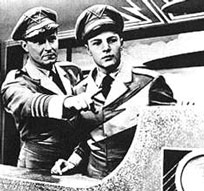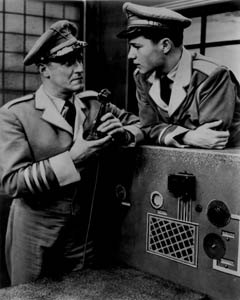“Captain Video! Electronic wizard! Master of time and space! Guardian of the safety of the world! Fighting for law and order, Captain Video operates from a mountain retreat with secret agents at all points of the globe. Possessing scientific secrets and scientific weapons, Captain Video asks no quarter and gives none to the forces of evil. Stand by for Captain Video and his Video Rangers!”
These are the words that viewers heard at the start of each episode of Captain Video and His Video Rangers, the first science fiction space adventure series on TV. Captain Video ran 5-6 days a week at 7pm on the now-defunct Dumont Network from 1949 to 1955, and was extremely popular with both children and adults. Set in the distant future on a secret mountain-top retreat, the series followed the adventures of Captain Video, leader of the Video Rangers, a group of fighters for truth and justice, as they battled evil scientists and other nefarious villains throughout the solar system.
Programmed as a continuing serial, Captain Video employed many of the early staples of children’s programming, like the inclusion of inexpensive film clips and pointed moral lessons, but it also capitalized on the growing public fascination with science and space. The show was live and technically demanding, using the new technology of television, like dissolves, superimpositions, and other crude effects to place Captain Video in fantasy surroundings and allow him to travel through space and time.
 Besides fighting for truth and justice, Captain Video was a technological genius who invented a variety of communications devices, like the Opticon Scillometer, a long-range, X-ray machine used to see through walls; the Discatron, a portable television screen which served as an intercom; and the Radio Scillograph, a palm-sized, two-way radio. Captain Video’s weapons were also futuristic inventions that were not designed to kill but to capture his opponents, like the Cosmic Ray Vibrator, a static beam of electricity that temporarily paralyzed its target, and the Electronic Strait Jacket, which placed captives in invisible restraints. Captain Video’s pro-social uses of science and technology contrasted with the evil purposes to which science was put by such villains as Dr. Pauli, a genius inventor who dressed in gangster-like pinstripe suits and spoke with a Nazi or Soviet-accented snarl.
Besides fighting for truth and justice, Captain Video was a technological genius who invented a variety of communications devices, like the Opticon Scillometer, a long-range, X-ray machine used to see through walls; the Discatron, a portable television screen which served as an intercom; and the Radio Scillograph, a palm-sized, two-way radio. Captain Video’s weapons were also futuristic inventions that were not designed to kill but to capture his opponents, like the Cosmic Ray Vibrator, a static beam of electricity that temporarily paralyzed its target, and the Electronic Strait Jacket, which placed captives in invisible restraints. Captain Video’s pro-social uses of science and technology contrasted with the evil purposes to which science was put by such villains as Dr. Pauli, a genius inventor who dressed in gangster-like pinstripe suits and spoke with a Nazi or Soviet-accented snarl.
Without the luxury of video tape and editing, the show’s scripts included a lot of exposition to set up short action scenes. To pick up the pace and allow time for the crew to change sets and prepare special effects, at some point each episode would have Captain Video or a Video Ranger communications officer at Ranger Headaquarters show short action-filled clips from cowboy movies, described as the adventures of Captain Video’s undercover agents on earth. In addition to commercials for Post Cereal, the series’ sponsor, other breaks between scenes were filled with Ranger Messages, which dealt with such global issues as freedom, the Golden Rule, and nondiscrimination, or ads for Video Ranger merchandise, like space helmets, secret code guns, flying saucer rings, decoder badges, and Viking rockets complete with launchers.
In the early days of the series, critics derided the show for its awkward scripts and acting. But after the show became a popular hit, such major science fiction writers as Damon Knight, Arthur C. Clarke, Robert Sheckley, and Isaac Asimov wrote more intelligent and imaginative scripts for the show.
Unfortunately, the Dumont Network couldn’t compete successfully as other new networks began to attract more viewers and more sponsors. Captain Video left the air on April 1, 1955, and DuMont folded later that same year. Because of a fire that destroyed most of Dumont’s film archive in the 1970’s, only five half-hour episodes of Captain Video and His Video Rangers are available to the public today. You can see two of them in the video clip above.
Other remaining episodes of Captain Video can be seen on DVD in Captain Video and His Video Rangers. Captain Video is also included in Fantastic Television: A Pictorial History of Sci-Fi, the Unusual and Fantastic from Captain Video to the Star Trek Phenomenon and Beyond (Hardcover).


Recent Comments